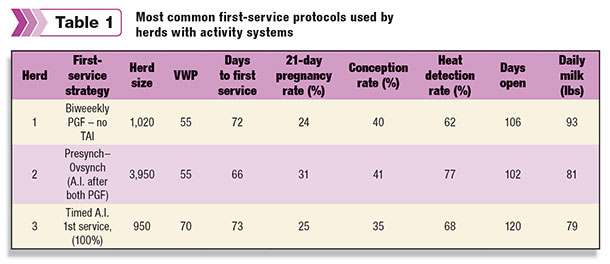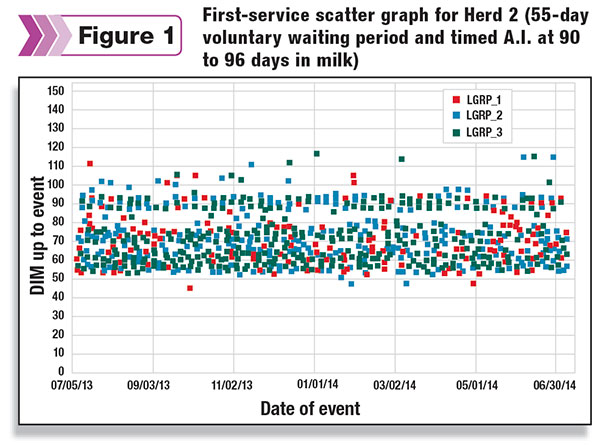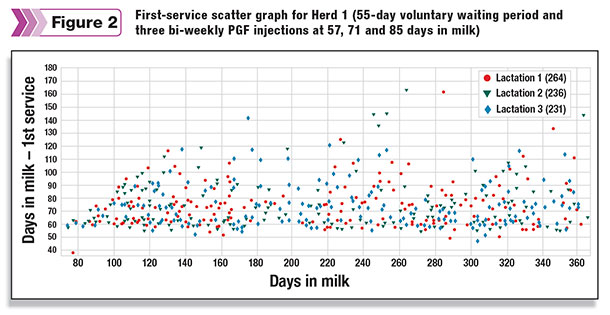Identifying cows in heat is the first basic step in a good breeding program. While activity monitors can be quite helpful in this task, many herds find success when this new technology is combined with a timed-A.I. program.
Heat detection rates in North American dairy herds that are based solely on visual observations are near the 50 percent range. Most large dairy operations use tail chalk or paint and once-daily observation, which is superior to visual observation.
However, there is still room for improvement, with service rates typically in the mid-60 percent range. Low detection rates led to the successful and profitable adoption of systematic timed-A.I. programs.
Despite the effectiveness of timed-A.I. programs, many producers desire to breed cows based on estrus behavior, citing their dislike for the frequent injections required with timed-A.I. protocols and the concern about public perception with the use of reproductive hormones.
The explosion of activity monitoring systems can be traced to the development of affordable, advanced computer technology that includes mini-printed circuit boards to track and transmit data as an on-board micro-computer.
Activity monitoring systems allow for individual cow management with unique data collection and interpretation, practically in real time. Though initially developed for heat detection, systems available today also monitor rumination, resting time, temperature and many other events associated with animal well-being.
Activity monitoring has many different approaches, from pedometers that measure walking activity to accelerometers that measure head movements and ear tags that filter the angle of the head and bobbing of the ear associated with estrus. Each system records movement and activity differently.
All systems include three or more basic components: the sensor on each cow, the receiver to collect the data from the sensors and computer software. Web applications, email alerts and smartphone or tablet programs are available with many of the current systems.

Protocols for first service
There are many ways to incorporate an activity monitoring system in your herd. The three most common protocols for first service used by producers who have activity systems appear in Table 1 .
- The most common approach is to combine activity monitoring with a safety net Ovsynch protocol at approximately 100 days in milk (DIM). Some producers administer two or three biweekly prostaglandin (PGF) injections to increase the number of cows in heat, making it easier to detect cows that usually have limited heat expression.
This tactic ensures all cows not detected by the system receive first insemination at a reasonable DIM (Herd 2, Table 1). For the vast majority of herds that use this approach, only 10 to 20 percent of the cows receive timed A.I. on first service.
Figure 1 illustrates that the majority of cows do not receive timed A.I. on first service. Many herds initially attempt this strategy to minimize hormone use but identify a sufficient number of anovular cows and incorporate an Ovsynch protocol with or without a CIDR device.
- Another strategy incorporates biweekly PGF without a timed-A.I. safety net. In place of timed A.I., (Herd 1, Table 1) ultrasound scanning after 95 DIM is performed on cows that have not been bred. If a corpus luteum (CL) is present, they receive a PGF injection; if the cow is cystic or anovular, a CIDR device is inserted.
They do not time breed following removal of the CIDR device, instead relying on the activity system. Figure 2 is the scatter graph that demonstrates the variation in days to first service when the cows are inseminated using an activity system.
- The most aggressive approach is to utilize a synchronization protocol with 100 percent timed A.I. on first service and an activity system for the detection of cows returning to estrus. This is a very expensive approach and is the least practiced by herds that have adopted an activity system.
Herd 3 used 100 percent timed A.I. for an extended period but recently changed to breeding using an activity system starting at 55 DIM with an Ovsynch protocol starting at 78 DIM.


Palpation pregnancy rates (PPR) and re-synchronization protocols
Most producers who install an activity system first observe an increase in PPR as a result of detecting more open cows. The three herds represented in Table 1 all have a PPR above 65 percent. Table 2 is the PPR for Herd 2.

You can find this information using the DairyComp305 command: PCT RC=5 BY PODAT FOR PODAT>-90 for LACT>0. The PPR is significantly lower in the summer when expression of estrus is low. Most herds practice one of two protocols for re-synchronization starting 28 to 35 days post-breeding: either traditional Ovsynch protocol on all cows at open check, or open cows with a CL receive PGF.
not inseminated by the next examination in seven days, the Ovsynch protocol is used. A cow initially examined without a CL is re-examined in seven days and receives Ovsynch either with or without a CIDR device if no CL is present. If a CL is present, the cow receives PGF.
It is recommended that you work with someone who has the expertise to help you manage the system properly, including how to best utilize synchronization protocols in combination with the activity system to maximize your results.
There will be a percentage of cows that will need some hormone intervention to assist them in overcoming anovular or cystic status. There are numerous protocols that can be used with an activity system to obtain excellent reproductive performance. PD
Ray Nebel is the V.P. of technical programs at Select Sires. He can be reached by email .

-
Ray Nebel
- V.P. of Technical Programs
- Select Sires
- Email Ray Nebel





